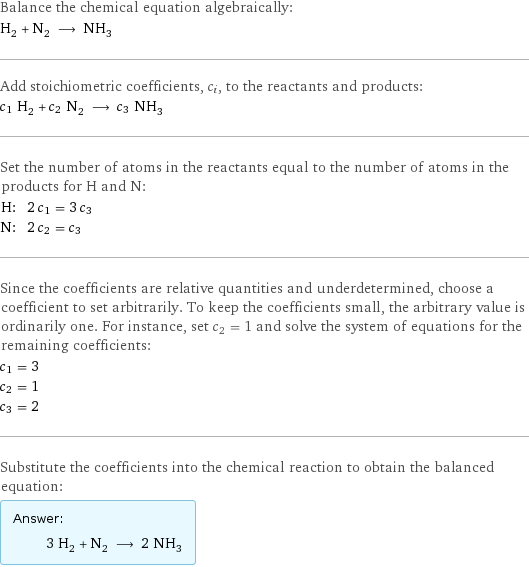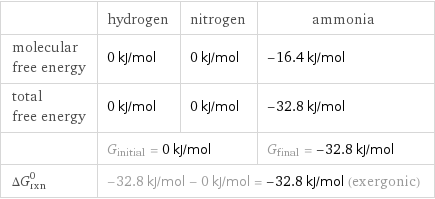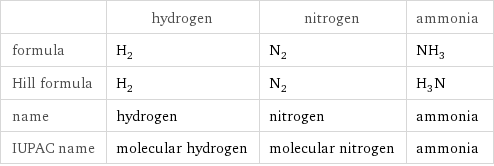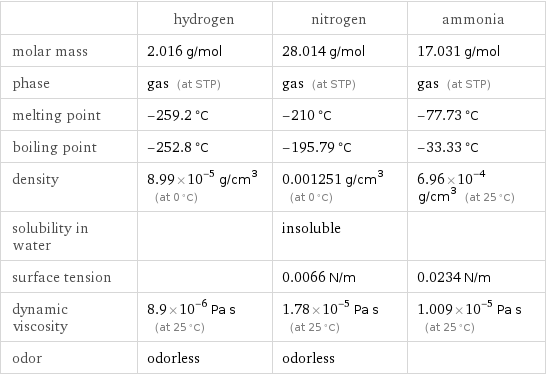Input interpretation

H_2 hydrogen + N_2 nitrogen ⟶ NH_3 ammonia
Balanced equation

Balance the chemical equation algebraically: H_2 + N_2 ⟶ NH_3 Add stoichiometric coefficients, c_i, to the reactants and products: c_1 H_2 + c_2 N_2 ⟶ c_3 NH_3 Set the number of atoms in the reactants equal to the number of atoms in the products for H and N: H: | 2 c_1 = 3 c_3 N: | 2 c_2 = c_3 Since the coefficients are relative quantities and underdetermined, choose a coefficient to set arbitrarily. To keep the coefficients small, the arbitrary value is ordinarily one. For instance, set c_2 = 1 and solve the system of equations for the remaining coefficients: c_1 = 3 c_2 = 1 c_3 = 2 Substitute the coefficients into the chemical reaction to obtain the balanced equation: Answer: | | 3 H_2 + N_2 ⟶ 2 NH_3
Structures

+ ⟶
Names

hydrogen + nitrogen ⟶ ammonia
Reaction thermodynamics
Enthalpy

| hydrogen | nitrogen | ammonia molecular enthalpy | 0 kJ/mol | 0 kJ/mol | -45.9 kJ/mol total enthalpy | 0 kJ/mol | 0 kJ/mol | -91.8 kJ/mol | H_initial = 0 kJ/mol | | H_final = -91.8 kJ/mol ΔH_rxn^0 | -91.8 kJ/mol - 0 kJ/mol = -91.8 kJ/mol (exothermic) | |
Gibbs free energy

| hydrogen | nitrogen | ammonia molecular free energy | 0 kJ/mol | 0 kJ/mol | -16.4 kJ/mol total free energy | 0 kJ/mol | 0 kJ/mol | -32.8 kJ/mol | G_initial = 0 kJ/mol | | G_final = -32.8 kJ/mol ΔG_rxn^0 | -32.8 kJ/mol - 0 kJ/mol = -32.8 kJ/mol (exergonic) | |
Entropy

| hydrogen | nitrogen | ammonia molecular entropy | 115 J/(mol K) | 192 J/(mol K) | 193 J/(mol K) total entropy | 345 J/(mol K) | 192 J/(mol K) | 386 J/(mol K) | S_initial = 537 J/(mol K) | | S_final = 386 J/(mol K) ΔS_rxn^0 | 386 J/(mol K) - 537 J/(mol K) = -151 J/(mol K) (exoentropic) | |
Equilibrium constant
![Construct the equilibrium constant, K, expression for: H_2 + N_2 ⟶ NH_3 Plan: • Balance the chemical equation. • Determine the stoichiometric numbers. • Assemble the activity expression for each chemical species. • Use the activity expressions to build the equilibrium constant expression. Write the balanced chemical equation: 3 H_2 + N_2 ⟶ 2 NH_3 Assign stoichiometric numbers, ν_i, using the stoichiometric coefficients, c_i, from the balanced chemical equation in the following manner: ν_i = -c_i for reactants and ν_i = c_i for products: chemical species | c_i | ν_i H_2 | 3 | -3 N_2 | 1 | -1 NH_3 | 2 | 2 Assemble the activity expressions accounting for the state of matter and ν_i: chemical species | c_i | ν_i | activity expression H_2 | 3 | -3 | ([H2])^(-3) N_2 | 1 | -1 | ([N2])^(-1) NH_3 | 2 | 2 | ([NH3])^2 The equilibrium constant symbol in the concentration basis is: K_c Mulitply the activity expressions to arrive at the K_c expression: Answer: | | K_c = ([H2])^(-3) ([N2])^(-1) ([NH3])^2 = ([NH3])^2/(([H2])^3 [N2])](../image_source/330aeafea799c7c3609f3f2c1d4e31df.png)
Construct the equilibrium constant, K, expression for: H_2 + N_2 ⟶ NH_3 Plan: • Balance the chemical equation. • Determine the stoichiometric numbers. • Assemble the activity expression for each chemical species. • Use the activity expressions to build the equilibrium constant expression. Write the balanced chemical equation: 3 H_2 + N_2 ⟶ 2 NH_3 Assign stoichiometric numbers, ν_i, using the stoichiometric coefficients, c_i, from the balanced chemical equation in the following manner: ν_i = -c_i for reactants and ν_i = c_i for products: chemical species | c_i | ν_i H_2 | 3 | -3 N_2 | 1 | -1 NH_3 | 2 | 2 Assemble the activity expressions accounting for the state of matter and ν_i: chemical species | c_i | ν_i | activity expression H_2 | 3 | -3 | ([H2])^(-3) N_2 | 1 | -1 | ([N2])^(-1) NH_3 | 2 | 2 | ([NH3])^2 The equilibrium constant symbol in the concentration basis is: K_c Mulitply the activity expressions to arrive at the K_c expression: Answer: | | K_c = ([H2])^(-3) ([N2])^(-1) ([NH3])^2 = ([NH3])^2/(([H2])^3 [N2])
Rate of reaction
![Construct the rate of reaction expression for: H_2 + N_2 ⟶ NH_3 Plan: • Balance the chemical equation. • Determine the stoichiometric numbers. • Assemble the rate term for each chemical species. • Write the rate of reaction expression. Write the balanced chemical equation: 3 H_2 + N_2 ⟶ 2 NH_3 Assign stoichiometric numbers, ν_i, using the stoichiometric coefficients, c_i, from the balanced chemical equation in the following manner: ν_i = -c_i for reactants and ν_i = c_i for products: chemical species | c_i | ν_i H_2 | 3 | -3 N_2 | 1 | -1 NH_3 | 2 | 2 The rate term for each chemical species, B_i, is 1/ν_i(Δ[B_i])/(Δt) where [B_i] is the amount concentration and t is time: chemical species | c_i | ν_i | rate term H_2 | 3 | -3 | -1/3 (Δ[H2])/(Δt) N_2 | 1 | -1 | -(Δ[N2])/(Δt) NH_3 | 2 | 2 | 1/2 (Δ[NH3])/(Δt) (for infinitesimal rate of change, replace Δ with d) Set the rate terms equal to each other to arrive at the rate expression: Answer: | | rate = -1/3 (Δ[H2])/(Δt) = -(Δ[N2])/(Δt) = 1/2 (Δ[NH3])/(Δt) (assuming constant volume and no accumulation of intermediates or side products)](../image_source/77480888247ac58be96a0f063a174578.png)
Construct the rate of reaction expression for: H_2 + N_2 ⟶ NH_3 Plan: • Balance the chemical equation. • Determine the stoichiometric numbers. • Assemble the rate term for each chemical species. • Write the rate of reaction expression. Write the balanced chemical equation: 3 H_2 + N_2 ⟶ 2 NH_3 Assign stoichiometric numbers, ν_i, using the stoichiometric coefficients, c_i, from the balanced chemical equation in the following manner: ν_i = -c_i for reactants and ν_i = c_i for products: chemical species | c_i | ν_i H_2 | 3 | -3 N_2 | 1 | -1 NH_3 | 2 | 2 The rate term for each chemical species, B_i, is 1/ν_i(Δ[B_i])/(Δt) where [B_i] is the amount concentration and t is time: chemical species | c_i | ν_i | rate term H_2 | 3 | -3 | -1/3 (Δ[H2])/(Δt) N_2 | 1 | -1 | -(Δ[N2])/(Δt) NH_3 | 2 | 2 | 1/2 (Δ[NH3])/(Δt) (for infinitesimal rate of change, replace Δ with d) Set the rate terms equal to each other to arrive at the rate expression: Answer: | | rate = -1/3 (Δ[H2])/(Δt) = -(Δ[N2])/(Δt) = 1/2 (Δ[NH3])/(Δt) (assuming constant volume and no accumulation of intermediates or side products)
Chemical names and formulas

| hydrogen | nitrogen | ammonia formula | H_2 | N_2 | NH_3 Hill formula | H_2 | N_2 | H_3N name | hydrogen | nitrogen | ammonia IUPAC name | molecular hydrogen | molecular nitrogen | ammonia
Substance properties

| hydrogen | nitrogen | ammonia molar mass | 2.016 g/mol | 28.014 g/mol | 17.031 g/mol phase | gas (at STP) | gas (at STP) | gas (at STP) melting point | -259.2 °C | -210 °C | -77.73 °C boiling point | -252.8 °C | -195.79 °C | -33.33 °C density | 8.99×10^-5 g/cm^3 (at 0 °C) | 0.001251 g/cm^3 (at 0 °C) | 6.96×10^-4 g/cm^3 (at 25 °C) solubility in water | | insoluble | surface tension | | 0.0066 N/m | 0.0234 N/m dynamic viscosity | 8.9×10^-6 Pa s (at 25 °C) | 1.78×10^-5 Pa s (at 25 °C) | 1.009×10^-5 Pa s (at 25 °C) odor | odorless | odorless |
Units
